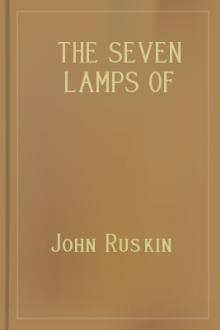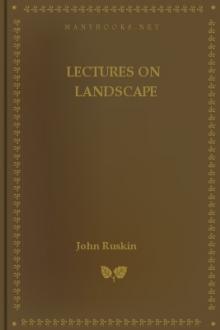The Seven Lamps of Architecture by John Ruskin (books like harry potter TXT) 📕

- Author: John Ruskin
- Performer: -
Book online «The Seven Lamps of Architecture by John Ruskin (books like harry potter TXT) 📕». Author John Ruskin
XV. Again, the distinction will be found to exist, not only between forms and shades as subjects of choice, but between essential and inessential forms. One of the chief distinctions between the dramatic and picturesque schools of sculpture is found in the treatment of the hair. By the artists of the time of Pericles it was considered as an excrescence,16 indicated by few and rude lines, and subordinated in every particular to the principality of the features and person. How completely this was an artistical, not a national idea, it is unnecessary to prove. We need but remember the employment of the Lacedæmonians, reported by the Persian spy on the evening before the battle of Thermopylæ, or glance at any Homeric description of ideal form, to see how purely sculpturesque was the law which reduced the markings of the hair, lest, under the necessary disadvantages of material, they should interfere with the distinctness of the personal forms. On the contrary, in later sculpture, the hair receives almost the principal care of the workman; and while the features and limbs are clumsily and bluntly executed, the hair is curled and twisted, cut into bold and shadowy projections, and arranged in masses elaborately ornamental: there is true sublimity in the lines and the chiaroscuro of these masses, but it is, as regards the creature represented, parasitical, and therefore picturesque. In the same sense we may understand the application of the term to modern animal painting, distinguished as it has been by peculiar attention to the colors, lustre, and texture of skin; nor is it in art alone that the definition will hold. In animals themselves, when their sublimity depends upon their muscular forms or motions, or necessary and principal attributes, as perhaps more than all others in the horse, we do not call them picturesque, but consider them as peculiarly fit to be associated with pure historical subject. Exactly in proportion as their character of sublimity passes into excrescences;—into mane and beard as in the lion, into horns as in the stag, into shaggy hide as in the instance above given of the ass colt, into variegation as in the zebra, or into plumage,—they become picturesque, and are so in art exactly in proportion to the prominence of these excrescential characters. It may often be most expedient that they should be prominent; often there is in them the highest degree of majesty, as in those of the leopard and boar; and in the hands of men like Tintoret and Rubens, such attributes become means of deepening the very highest and most ideal impressions. But the picturesque direction of their thoughts is always distinctly recognizable, as clinging to the surface, to the less essential character, and as developing out of this a sublimity different from that of the creature itself; a sublimity which is, in a sort, common to all the objects of creation, and the same in its constituent elements, whether it be sought in the clefts and folds of shaggy hair, or in the chasms and rents of rocks, or in the hanging of thickets or hill sides, or in the alternations of gaiety and gloom in the variegation of the shell, the plume, or the cloud.
XVI. Now, to return to our immediate subject, it so happens that, in architecture, the superinduced and accidental beauty is most commonly inconsistent with the preservation of original character, and the picturesque is therefore sought in ruin, and supposed to consist in decay. Whereas, even when so sought, it consists in the mere sublimity of the rents, or fractures, or stains, or vegetation, which assimilate the architecture with the work of Nature, and bestow upon it those circumstances of color and form which are universally beloved by the eye of man. So far as this is done, to the extinction of the true characters of the architecture, it is picturesque, and the artist who looks to the stem of the ivy instead of the shaft of the pillar, is carrying out in more daring freedom the debased sculptor's choice of the hair instead of the countenance. But so far as it can be rendered consistent with the inherent character, the picturesque or extraneous sublimity of architecture has just this of nobler function in it than that of any other object whatsoever, that it is an exponent of age, of that in which, as has been said, the greatest glory of a building consists; and, therefore, the external signs of this glory, having power and purpose greater than any belonging to their mere sensible beauty, may be considered as taking rank among pure and essential character; so essential to my mind, that I think a building cannot be considered as in its prime until four or five centuries have passed over it; and that the entire choice and arrangement of its details should have reference to their appearance after that period, so that none should be admitted which would suffer material injury either by the weather-staining, or the mechanical degradation which the lapse of such a period would necessitate.
XVII. It is not my purpose to enter into any of the questions which the application of this principle involves. They are of too great interest and complexity to be even touched upon within my present limits, but this is broadly to be noticed, that those styles of architecture which are picturesque in the sense above explained with respect to sculpture, that is to say, whose decoration depends on the arrangement of points of shade rather than on purity of outline, do not suffer, but commonly gain in richness of effect when their details are partly worn away; hence such styles, pre-eminently that of French Gothic, should always be adopted when the materials to be employed are liable to degradation, as brick, sandstone, or soft limestone; and styles in any degree dependent on purity of line, as the Italian Gothic, must be practised altogether in hard and undecomposing materials, granite serpentine, or crystalline marbles. There can be no doubt that the nature of the accessible materials influenced the formation of both styles; and it should still more authoritatively determine our choice of either.
XVIII. It does not belong to my present plan to consider at length the second head of duty of which I have above spoken; the preservation of the architecture we possess: but a few words may be forgiven, as especially necessary in modern times. Neither by the public, nor by those who have the care of public monuments, is the true meaning of the word restoration understood. It means the most total destruction which a building can suffer: a destruction out of which no remnants can be gathered; a destruction accompanied with false description of the thing destroyed. Do not let us deceive ourselves in this important matter; it is impossible, as impossible as to raise the dead, to restore anything that has ever been great or beautiful in architecture. That which I have above insisted upon as the life of the whole, that spirit which is given only by the hand and eye of the workman, never can be recalled. Another spirit may be given by another time, and it is then a new building; but the spirit of the dead workman cannot be summoned up, and commanded to direct other hands, and other thoughts. And as for direct and simple copying, it is palpably impossible. What copying can there be of surfaces that have been worn half an inch down? The whole finish of the work was in the half inch that is gone; if you attempt to restore that finish, you do it conjecturally; if you copy what is left, granting fidelity to be possible (and what care, or watchfulness, or cost can secure it?), how is the new work better than the old? There was yet in the old some life, some mysterious suggestion of what it had been, and of what it had lost; some sweetness in the gentle lines which rain and sun had wrought. There can be none in the brute hardness of the new carving. Look at the animals which I have given in Plate 14, as an instance of living work, and suppose the markings of the scales and hair once worn away, or the wrinkles of the brows, and who shall ever restore them? The first step to restoration (I have seen it, and that again and again, seen it on the Baptistery of Pisa, seen it on the Casa d' Oro at Venice, seen it on the Cathedral of Lisieux), is to dash the old work to pieces; the second is usually to put up the cheapest and basest imitation which can escape detection, but in all cases, however careful, and however labored, an imitation still, a cold model of such parts as can be modelled, with conjectural supplements; and my experience has as yet furnished me with only one instance, that of the Palais de Justice at Rouen, in which even this, the utmost degree of fidelity which is possible, has been attained or even attempted.
XIX. Do not let us talk then of restoration. The thing is a Lie from beginning to end. You may make a model of a building as you may of a corpse, and your model may have the shell of the old walls within it as your cast might have the skeleton, with what advantage I neither see nor care; but the old building is destroyed, and that more totally and mercilessly than if it had sunk into a heap of dust, or melted into a mass of clay: more has been gleaned out of desolated Nineveh than ever will be out of re-built Milan. But, it is said, there may come a necessity for restoration! Granted. Look the necessity full in the face, and understand it on its own terms. It is a necessity for destruction. Accept it as such, pull the building down, throw its stones into neglected corners, make ballast of them, or mortar, if you will; but do it honestly, and do not set up a Lie in their place. And look that necessity in the face before it comes, and you may prevent it. The principle of modern times (a principle which I believe, at





Comments (0)